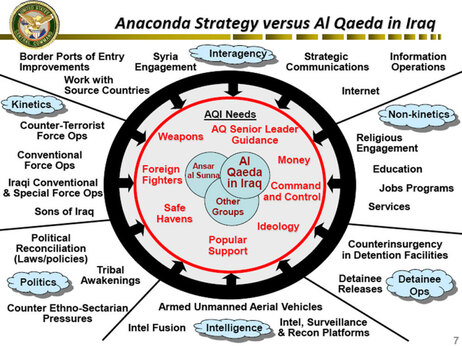A couple months ago I heard a piece on NPR about how PowerPoint is being used by the United States military. I have included a power point slide that was mentioned in the report.

The piece can be found HERE. I think this article from the NYT helps to sum up my stance on PP: "The amount of time expended on PowerPoint, the Microsoft presentation program of computer-generated charts, graphs and bullet points, has made it a running joke in the Pentagon and in Iraq and Afghanistan." In other words, a large amount of the time spent incorporating PP into a presentation could be better spent making that presentation more informative and concise. Also, the mere fact that you are being required to concentrate on static displays forces people to divide their attention between the speaker and the screen. We spend more time furiously copying the info bullets into our notebooks then we spend trying to grasp the content’s meaning. This, I feel, makes it twice as hard to really absorb the material.
As for PP in the classroom? I am extremely opposed to it. Have you ever attended a memorable lecture that was based on PP slides? The best lectures involve active teacher/student discussion and relevant anecdotes. As far as the information PPs are intended to convey, the teachers could save themselves time by creating an outline and distributing it electronically before or after class. However, although I hate the teacher’s use of PP, I do think it can be used effectively by students in a presentation.
For one thing, the mere act of working in a digital medium helps to expose children to the type of work they will be doing for the rest of their lives. PP presentations require Google image searches, typing, MS Office skills, and a wide rang of other online skills that will serve them well as they get older. Also, for kids, the bells and whistles of PowerPoint can be fun and exciting. Students can really personalize their presentations. The medium allows them to express information that they would have difficulty expressing in a different format. So, for teachers, PP should be avoided like the plague. However, PP can be used effectively by students to present what they have learned in an assignment or as part of a presentation.